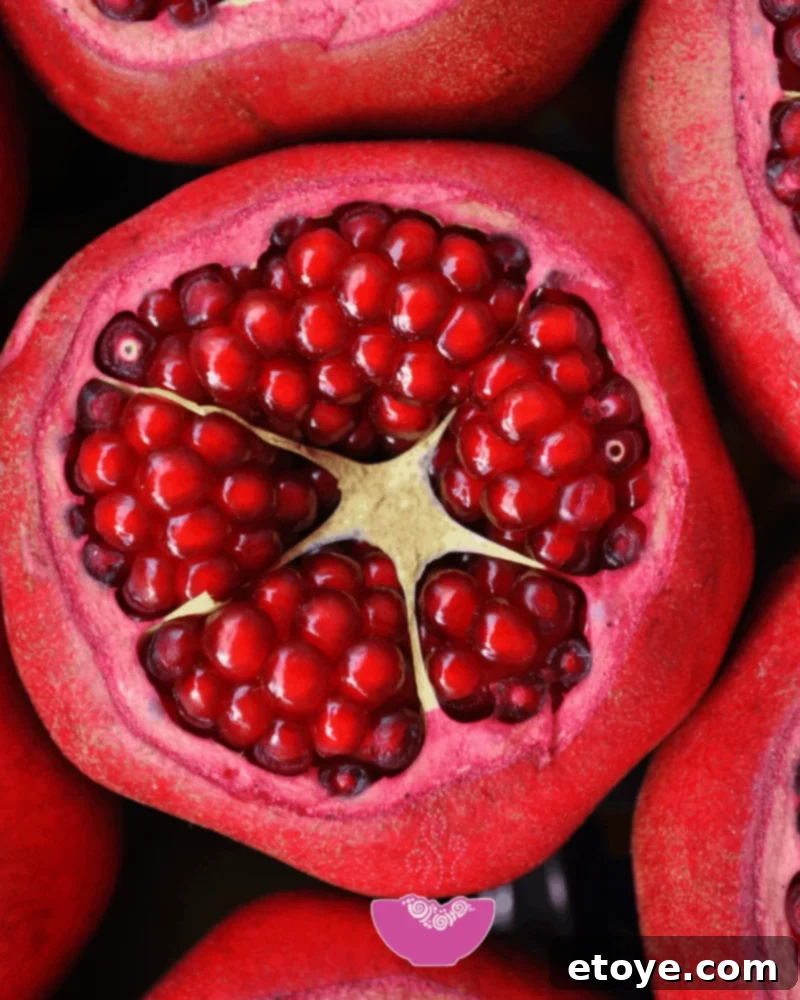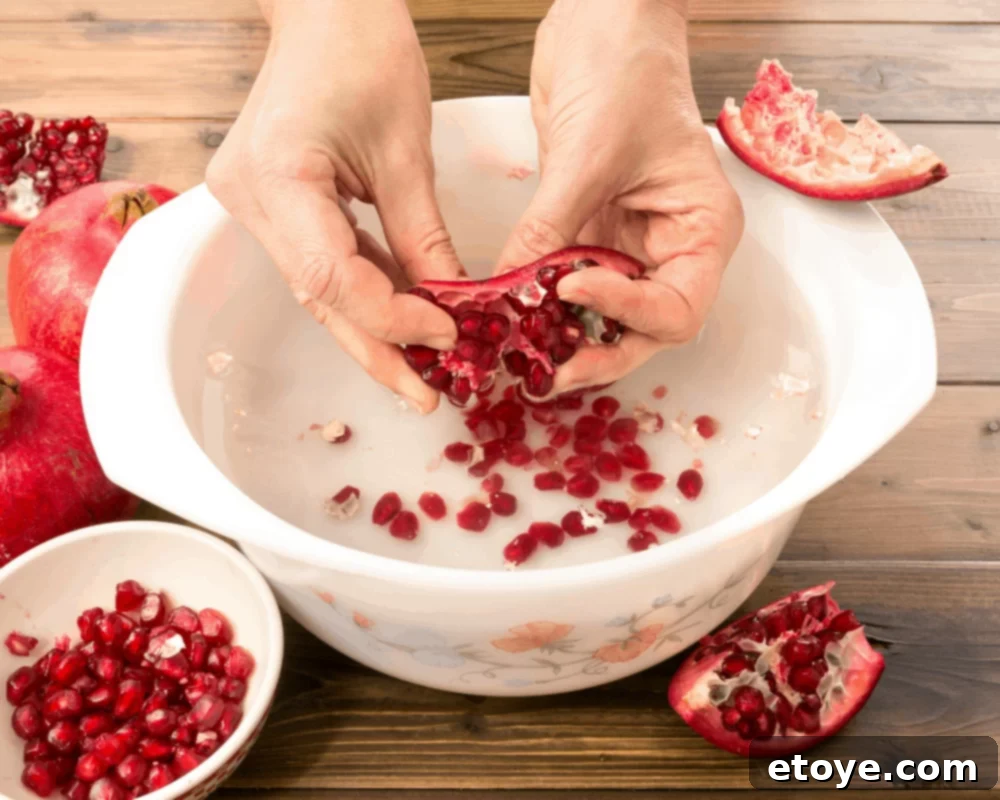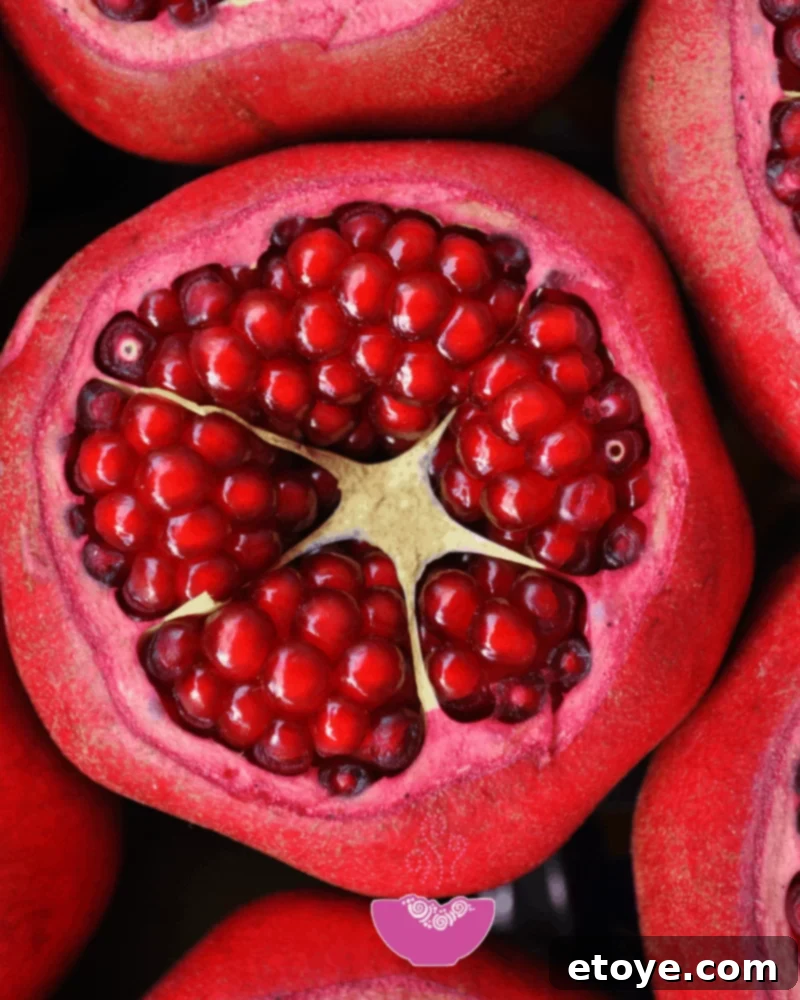Welcome to the vibrant world of pomegranates! These ancient fruits offer a burst of sweet-tart flavor and a delightful crunch, making them a superb addition to everything from salads to desserts. If you’ve ever found yourself hesitating to incorporate these ruby jewels into your meals, especially a healthy Buddha Bowl, due to the perceived challenge of deseeding or selecting the perfect one, you’re in the right place. This comprehensive guide will transform you into a pomegranate pro, covering everything from choosing the freshest fruit to effortlessly extracting its precious arils, and exploring the myriad ways this superfood can enhance your diet. Get ready to unlock the full potential of pomegranates and elevate your culinary creations!

Elevate Your Buddha Bowl with Pomegranate Seeds
Buddha Bowls have taken the healthy eating world by storm, and for good reason. They are versatile, nutritious, and incredibly satisfying, typically featuring a base of grains, a protein source, an array of colorful vegetables, and a dressing. But what truly sets a Buddha Bowl apart is often the unexpected elements that add texture, flavor, and a nutritional boost. This is precisely where pomegranate seeds shine!

Incorporating pomegranate arils (seeds) into your Buddha Bowl introduces an exciting dimension. Their juicy, slightly tart, and subtly sweet profile cuts through richer flavors, while their signature crunch provides a delightful textural contrast to softer grains and steamed vegetables. Beyond taste and texture, these tiny gems infuse your meal with a powerful dose of antioxidants and essential nutrients, transforming a simple bowl into a truly nourishing and gourmet experience. Whether sprinkled over roasted vegetables, mixed into a grain salad, or used as a colorful garnish, pomegranate seeds are a simple yet impactful way to elevate your Buddha Bowl from good to extraordinary. They add a vibrant pop that makes your meal not just healthier, but also more visually appealing and enjoyable.
The Irresistible Benefits of Pomegranate Seeds
Pomegranate seeds, also known as arils, are much more than just a pretty topping. They are a nutritional powerhouse packed with goodness that contributes significantly to a healthy diet. Their unique combination of flavor, texture, and health benefits makes them an invaluable addition to any kitchen.
- A Delicious and Healthy Crunch: Unlike many healthy snack options, pomegranate seeds offer a satisfying crunch that’s both refreshing and engaging. This makes them a perfect alternative to less healthy crunchy snacks and adds an exciting textural element to any dish.
- Rich Source of Nutrients: Pomegranates are celebrated for their impressive nutrient profile. They are an excellent source of Vitamin C, a powerful antioxidant vital for immune function and skin health, and Vitamin K, essential for blood clotting and bone health. They also provide a good amount of folate, important for cell growth, and potassium, crucial for maintaining fluid balance and blood pressure.
- Abundant in Antioxidants: Perhaps the most lauded benefit of pomegranates is their incredibly high antioxidant content. They contain potent compounds like punicalagins, which are responsible for most of the fruit’s antioxidant activity, offering robust protection against free radical damage and oxidative stress. This contributes to overall cellular health and disease prevention.
- Excellent Source of Fiber: Each serving of pomegranate seeds provides a significant amount of dietary fiber. Fiber is crucial for digestive health, promoting regularity, and aiding in the feeling of fullness, which can support weight management. It also plays a role in regulating blood sugar levels and lowering cholesterol.
- Extended Freshness: When stored correctly, whole pomegranates can last for weeks, and their arils can stay fresh in the refrigerator for up to five days. This makes them a convenient ingredient to have on hand for quick additions to meals throughout the week without worrying about spoilage.
How to Select the Perfect Pomegranate at the Grocery Store
Choosing a ripe and flavorful pomegranate can seem daunting, but with a few simple tips, you’ll be selecting the best ones every time. A well-chosen pomegranate promises juicy, vibrant arils and a superior taste experience. Here’s what to look for when you’re at the produce aisle:
When choosing a pomegranate at the store, prioritize those that are bright in color. Look for a deep, uniform red hue across the entire surface of the fruit. Avoid any pomegranates that appear dull, pale, or have noticeable green patches, as these may indicate immaturity or a lack of ripeness. The skin should be taut and unbroken, without any visible blemishes or signs of shriveling.
Next, pay attention to the shape and feel. A perfect pomegranate should look round or slightly hexagonal and feel impressively dense for its size. This density is a strong indicator that the arils inside are plump and full of juice. Gently roll the fruit in your hand; it should feel heavy and solid. Avoid pomegranates that feel light, as this suggests the arils might be dry or underdeveloped.
Finally, inspect the skin for any soft spots, bruises, or cracks. Soft spots can be a sign of spoilage or internal damage, while cracks can expose the arils to air and spoilage. The skin should be firm and relatively smooth, though some minor superficial marks are normal and don’t affect the fruit’s quality. While you can sometimes find pre-packaged pomegranate seeds in the produce section, selecting a whole fruit and deseeding it yourself often ensures maximum freshness and a more economical choice.
Optimal Storage Methods for Pomegranates
Ensuring your pomegranates stay fresh for as long as possible is key to enjoying their delicious arils whenever you desire. Proper storage varies depending on whether the fruit is whole or already deseeded. Follow these guidelines to maximize their shelf life and preserve their vibrant flavor.
For whole pomegranates, the best approach is to store them on your kitchen counter, but in a cool place away from direct sunlight. In these conditions, whole pomegranates can impressively remain fresh for 2-3 weeks, sometimes even longer if your kitchen is particularly cool. Avoid placing them near heat sources, as this will accelerate their ripening and potential spoilage. If you plan to store them for an extended period, or if your home is warm, whole pomegranates can also be kept in the refrigerator’s crisper drawer for up to 2 months, though their skin might slightly harden.
Once you’ve removed the arils (seeds), their storage requirements change. Pomegranate seeds should always be stored in the refrigerator. Transfer them to an airtight container or a resealable plastic baggie to prevent them from drying out or absorbing other odors from your fridge. When stored properly in an airtight environment, these beautiful arils will maintain their freshness, juiciness, and crisp texture for up to five days. You can also freeze pomegranate arils for longer storage; simply spread them in a single layer on a baking sheet, freeze until solid, then transfer to a freezer-safe bag or container. Frozen arils can last for several months and are perfect for smoothies or as a garnish when thawed.
Mastering the Art of Deseeding a Pomegranate
The thought of deseeding a pomegranate can intimidate many, often leading to colorful (and messy!) kitchen experiences. However, with the right technique, extracting those jewel-like arils can be surprisingly simple and mess-free. The secret lies in a method that keeps everything contained and prevents those notorious stains from marring your hands, counter, and clothes.
The most effective and widely recommended technique is the underwater method. This ingenious approach leverages the different densities of the pomegranate components to separate them effortlessly. Here’s how to do it:
- Prepare Your Workstation: Begin by filling a large bowl or a clean sink basin with enough cool water to fully submerge a pomegranate. Having ample water is key to containing the mess.
- Score the Fruit: Carefully cut off the top and bottom ends of the pomegranate, just enough to expose the arils slightly. Next, using a small paring knife, gently score the pomegranate around its circumference, from top to bottom, following the natural ridges of the fruit. Imagine you’re outlining where you would peel an orange, cutting only through the skin and not deeply into the arils. Typically, this means scoring into 4-6 sections.
- Submerge and Separate: Fully submerge the scored pomegranate into the bowl of water. While underwater, use your hands and fingers to gently pry apart the sections along your scores. The water acts as a buffer, preventing the juice from splattering and staining your surroundings.
- Loosen the Seeds: Still submerged, use your fingers to gently loosen the seeds (arils) from the white pith and membrane. You’ll notice a remarkable phenomenon: the heavy, juicy arils will sink to the bottom of the bowl, while the lighter, bitter white pith pieces will float to the surface. This makes separation incredibly easy.
- Clean and Drain: Once all the arils are separated, skim off and discard all the floating white pith and outer skin pieces from the water’s surface. Then, carefully drain the water, leaving behind a bowl full of perfectly clean, intact, and ready-to-use pomegranate arils. You can use a colander to assist with draining if preferred.

This method not only saves you from sticky hands and stained surfaces but also makes the process much more enjoyable and efficient. You’ll be left with perfectly separated arils, ready to enhance your next meal or snack.
Beyond the Bowl: Creative Culinary Uses for Pomegranate Arils
While pomegranate arils are undeniably fantastic in Buddha Bowls, their versatility extends far beyond. These vibrant jewels can elevate a wide array of dishes, adding a unique blend of sweetness, tartness, and crunch. Don’t limit their potential; explore these creative ways to incorporate pomegranates into your daily cooking.
- Salads Reimagined: Pomegranate arils are a game-changer for green salads. Their bright flavor pairs wonderfully with bitter greens like arugula or radicchio, while their crunch complements softer textures. Try them in a winter salad with goat cheese, walnuts, and a balsamic vinaigrette, or in a couscous salad with mint and cucumber for a refreshing twist.
- Dessert Delight: Elevate your desserts with a sprinkle of pomegranate. They add a sophisticated touch to yogurt parfaits, fruit salads, and even chocolate desserts. Garnish cheesecake, ice cream, or pavlova with them for a burst of color and flavor. They’re also exquisite baked into muffins or as a topping for oatmeal.
- Savory Pairings: Pomegranates aren’t just for sweet dishes. Their tartness beautifully cuts through rich, savory flavors. Sprinkle them over roasted chicken or lamb, use them in a festive rice pilaf, or incorporate them into a vibrant salsa for fish tacos. They also make an excellent addition to dips like guacamole or hummus, providing an unexpected textural pop.
- Beverage Booster: Add a handful of arils to your sparkling water, iced tea, or cocktails for an instant upgrade. Their juice infuses a subtle flavor, and the arils themselves make for a beautiful, edible garnish. You can also press them for fresh pomegranate juice, perfect for smoothies or homemade dressings.
- Breakfast Brilliance: Start your day with a burst of flavor and nutrition. Pomegranate arils are perfect stirred into oatmeal, topped on Greek yogurt, or mixed into pancake or waffle batter for a delightful twist.
With these ideas, you’ll find that pomegranate arils can easily become a staple ingredient, bringing their unique charm to nearly every course.
Pomegranate Power: A Deep Dive into Health Benefits
The ancient history of the pomegranate is intertwined with its reputation as a symbol of health and vitality. Modern science increasingly supports these age-old beliefs, identifying the pomegranate as a legitimate superfood with a wide range of impressive health benefits. These benefits are largely attributed to its unique composition of antioxidants, vitamins, and anti-inflammatory compounds.
- Heart Health Champion: Pomegranates are a friend to your cardiovascular system. Studies suggest that the potent antioxidants in pomegranates, particularly punicalagins, can help reduce blood pressure, lower levels of LDL (bad) cholesterol, and prevent the oxidation of cholesterol, a key factor in the development of atherosclerosis (hardening of the arteries). Regular consumption may also improve blood flow and protect the lining of blood vessels.
- Anti-Inflammatory Properties: Chronic inflammation is a root cause of many serious diseases. Pomegranates possess powerful anti-inflammatory effects, primarily due to their high concentration of antioxidants. These compounds help to combat inflammation throughout the body, potentially offering relief and protective benefits against conditions like arthritis, type 2 diabetes, and certain cancers.
- Immune System Support: Loaded with Vitamin C, pomegranates are excellent for bolstering your immune system. Vitamin C is a crucial antioxidant that helps protect cells from damage and supports the production and function of various immune cells, helping your body ward off infections and illnesses.
- Rich in Dietary Fiber: As mentioned, pomegranate arils are a great source of dietary fiber. Fiber is vital for maintaining a healthy digestive system, promoting regular bowel movements, and preventing constipation. It also contributes to gut health by feeding beneficial gut bacteria, which can influence overall well-being.
- Potential Cancer-Fighting Properties: Emerging research suggests that pomegranate extract and juice may have anti-cancer properties. Studies have explored its potential to inhibit the growth of certain cancer cells, including those of prostate and breast cancer, and to induce apoptosis (programmed cell death) in these cells. While more research is needed, the findings are promising.
- Cognitive Benefits: The antioxidants in pomegranates may also offer neuroprotective benefits, potentially helping to improve memory and cognitive function. Their ability to reduce oxidative stress could play a role in protecting brain cells from damage.
Integrating pomegranates into your diet is a delicious way to harness these impressive health advantages, contributing to your overall well-being and longevity.
Now that you’re armed with all the knowledge to choose, store, deseed, and creatively use pomegranates, there’s no limit to the culinary adventures you can embark on. Whether you’re enhancing a vibrant Buddha Bowl, adding a pop to your salads, or exploring new dessert and savory applications, pomegranates are sure to impress. If you’ve tried removing pomegranate seeds using our underwater method, or have any other tips or favorite recipes featuring this incredible fruit, please share your experience! We’d love to hear how it turned out and any creative ways you’ve incorporated pomegranates into your meals in the comments below. Happy cooking!
